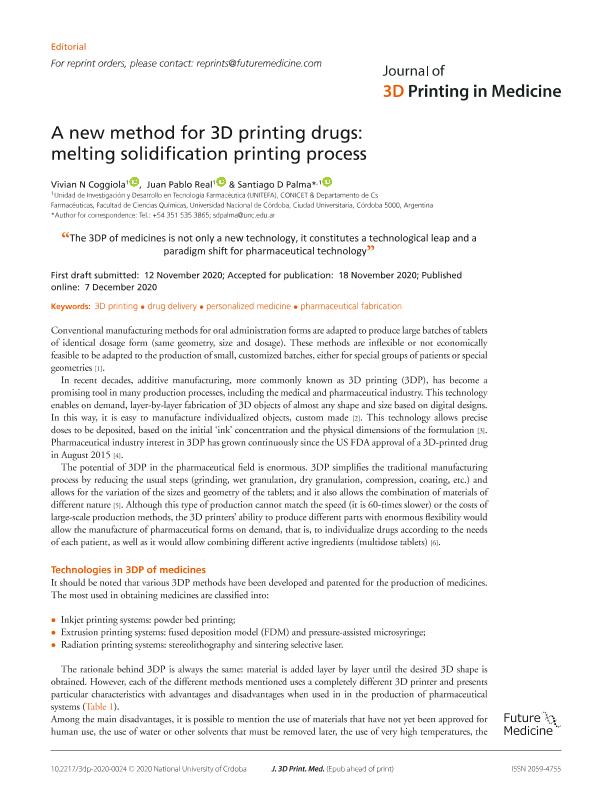Mostrar el registro sencillo del ítem
dc.contributor.author
Coggiola, Vivian Natali

dc.contributor.author
Real, Juan Pablo

dc.contributor.author
Palma, Santiago Daniel

dc.date.available
2021-07-27T14:47:18Z
dc.date.issued
2020-09
dc.identifier.citation
Coggiola, Vivian Natali; Real, Juan Pablo; Palma, Santiago Daniel; A new method for 3D printing drugs: Melting solidification printing process; Future Medicine; Journal of 3D Printing in Medicine; 4; 3; 9-2020; 131-134
dc.identifier.issn
2059-4755
dc.identifier.uri
http://hdl.handle.net/11336/137049
dc.description.abstract
Conventional manufacturing methods for oral administration forms are adapted to produce large batches of tablets of identical dosage form (same geometry, size and dosage). These methods are inflexible or not economically feasible to be adapted to the production of small, customized batches, either for special groups of patients or special geometries . In recent decades, additive manufacturing, more commonly known as 3D printing (3DP), has become a promising tool in many production processes, including the medical and pharmaceutical industry. This technology enables on demand, layer-by-layer fabrication of 3D objects of almost any shape and size based on digital designs. In this way, it is easy to manufacture individualized objects, custom made . This technology allows precise doses to be deposited, based on the initial ?ink? concentration and the physical dimensions of the formulation . Pharmaceutical industry interest in 3DP has grown continuously since the US FDA approval of a 3D-printed drug in August 2015. The potential of 3DP in the pharmaceutical field is enormous. 3DP simplifies the traditional manufacturing process by reducing the usual steps (grinding, wet granulation, dry granulation, compression, coating, etc.) and allows for the variation of the sizes and geometry of the tablets; and it also allows the combination of materials of different nature . Although this type of production cannot match the speed (it is 60-times slower) or the costs of large-scale production methods, the 3D printers? ability to produce different parts with enormous flexibility would allow the manufacture of pharmaceutical forms on demand, that is, to individualize drugs according to the needs of each patient, as well as it would allow combining different active ingredients (multidose tablets)
dc.format
application/pdf
dc.language.iso
eng
dc.publisher
Future Medicine
dc.rights
info:eu-repo/semantics/openAccess
dc.rights.uri
https://creativecommons.org/licenses/by-nc-sa/2.5/ar/
dc.subject
3D PRINTING
dc.subject
DRUG DELIVERY
dc.subject
PERSONALIZED MEDICINE
dc.subject
PHARMACEUTICAL FABRICATION
dc.subject.classification
Otras Ingeniería de los Materiales

dc.subject.classification
Ingeniería de los Materiales

dc.subject.classification
INGENIERÍAS Y TECNOLOGÍAS

dc.title
A new method for 3D printing drugs: Melting solidification printing process
dc.type
info:eu-repo/semantics/article
dc.type
info:ar-repo/semantics/artículo
dc.type
info:eu-repo/semantics/publishedVersion
dc.date.updated
2021-04-23T18:33:55Z
dc.identifier.eissn
2059-4763
dc.journal.volume
4
dc.journal.number
3
dc.journal.pagination
131-134
dc.journal.pais
Reino Unido

dc.journal.ciudad
Londres
dc.description.fil
Fil: Coggiola, Vivian Natali. Consejo Nacional de Investigaciones Científicas y Técnicas. Centro Científico Tecnológico Conicet - Córdoba. Unidad de Investigación y Desarrollo en Tecnología Farmacéutica. Universidad Nacional de Córdoba. Facultad de Ciencias Químicas. Unidad de Investigación y Desarrollo en Tecnología Farmacéutica; Argentina
dc.description.fil
Fil: Real, Juan Pablo. Consejo Nacional de Investigaciones Científicas y Técnicas. Centro Científico Tecnológico Conicet - Córdoba. Unidad de Investigación y Desarrollo en Tecnología Farmacéutica. Universidad Nacional de Córdoba. Facultad de Ciencias Químicas. Unidad de Investigación y Desarrollo en Tecnología Farmacéutica; Argentina
dc.description.fil
Fil: Palma, Santiago Daniel. Consejo Nacional de Investigaciones Científicas y Técnicas. Centro Científico Tecnológico Conicet - Córdoba. Unidad de Investigación y Desarrollo en Tecnología Farmacéutica. Universidad Nacional de Córdoba. Facultad de Ciencias Químicas. Unidad de Investigación y Desarrollo en Tecnología Farmacéutica; Argentina
dc.journal.title
Journal of 3D Printing in Medicine
dc.relation.alternativeid
info:eu-repo/semantics/altIdentifier/url/https://www.futuremedicine.com/doi/10.2217/3dp-2020-0024
dc.relation.alternativeid
info:eu-repo/semantics/altIdentifier/doi/http://dx.doi.org/10.2217/3dp-2020-0024
Archivos asociados
